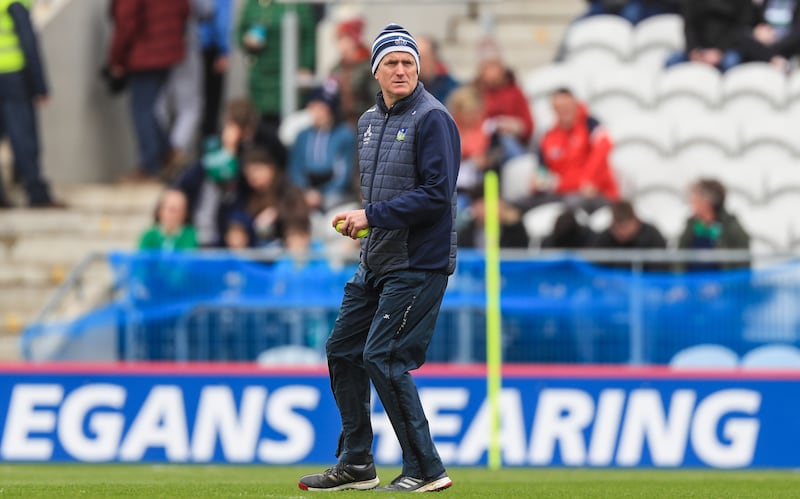About 45 minutes before Limerick played Galway in round three of the league in Pearse Stadium the Limerick backroom team arranged everything for the warm-up: every cone in its designated place and an abundance of sliotars, primed for the prematch drills. With their work done, the Limerick lads returned to the dressingroom for a few minutes, but as soon as their backs were turned a scurry of Artful Dodgers came through a gate behind the goal. In a lightning guerrilla manoeuvre they took their fill of Limerick’s sliotars and retreated fast to the sanctuary of the terrace.
Apart from the second half against Cork on the opening night of the league, it was probably the only other time this year that Limerick have been blindsided by anything. Unlike last year, when they plodded through the league looking a little leaden and a little behind schedule and a little vulnerable, they decided this year that it suited them to win the competition. They could, so they did.
One of the scourges of punditry is recency bias, and in the GAA the league has always been a fertile source for this lightheadedness. The championship prospects of impressive league winners are routinely inflated, even though we would have spent the previous couple of months scanning results and performances for low-level conspiracies.
Is there any reason to doubt what we saw from Limerick in the playoff rounds of the league and at various other stages along the way? Perhaps the only thing is to ask how much of an investment anybody made in chasing Limerick’s scalp so early in the year. Galway fielded only about a third of the team that had lined up against Limerick in last year’s All-Ireland semi-final, and whatever reserves of energy and aggression Clare are stockpiling for the championship, they didn’t dip into that fund for a league match in February.
Joe Biden may be best to let sleeping dogs lie as new books lifts lid on his final days in office
An Irishman in Israel: Is it better for my Israeli daughters to grow up in Tel Aviv or Dublin?
Mark O’Connell: I recommend the funny, sad video of Ashton Hall’s morning ritual. Start time: 3.52am
‘I’m not an easy man to please’: How Christy Ring and Louis Marcus came together to shoot a landmark film
It is natural to wonder how teams are going to manage their puck-outs against Limerick’s full-court press and their imperious half-back line and their deep-lying centrefielders, but equally, if they have something ingenuous in mind, they’re not going to reveal it in a league match.
None of that, though, is of any consequence to Limerick: they had their own purpose. As Paul Keane pointed out on these pages last week, only Cork used more players in this year’s competition than the All-Ireland champions. The level of turnover in their selections was more in line with a new management searching for a team, when in Limerick’s case they were really only looking for viable subs and emergency options.
In the four All-Ireland finals that Limerick have won, the starting 15 has been drawn from just 17 players. Given his age and various injuries, Graeme Mulcahy is the only player from that group who may have fallen down the pecking order, but given Limerick’s very specific demands on their roving inside forward, only Mulcahy and Peter Casey have been trusted consistently to play that role.
It is easy to say that Limerick’s squad is deeper than ever, but there is still a significant gap between their All-Ireland starters and most of the players in behind. Colin Coughlan and Cathal O’Neill both joined the panel as Leaving Cert students, three years ago now, but they have played less than 10 minutes between them in All-Ireland finals.
Of the emerging players who were auditioned in this year’s league, none of them have so far reached the level of Coughlan and O’Neill, and yet Coughlan and O’Neill would still not be starters in a crunch championship match if everyone was available.
Much was made of Limerick’s wayward shooting on Sunday, and John Kiely was clearly bothered by it. In mastering the art of the game Limerick are very respectful of the science, and are always mindful of efficiency. The Limerick manager made specific reference to “decision-making” in their shooting, and some of their shot selection had a scattergun quality. Gearoid Hegarty made two, rash, long range attempts from under the North Stand that would be against Limerick’s religion.

Their relationship with wides, though, is nuanced. Sean O’Donnell, Limerick’s lead analyst, is a hugely respected and influential figure in their back room team, and one of his first missions was to convince Kiely and Paul Kinnerk of the inherent statistical value of being the team that takes the most shots. He had the data to back it up: in the vast majority of games the team that shoots most, wins.
That wasn’t a licence for crazy shooting or solo pops for glory, which characterised some of Limerick’s misses on Sunday. But what it meant was that a certain tolerance for wides was built into their thinking. Limerick will expect to have more than 40 shots at the target on any given day, and will regularly hit numbers in the high-40s. On Sunday, they reached those levels.
And the wides? When Kilkenny beat Limerick in the 2019 All-Ireland semi-final, Kiely bemoaned their efficiency that day too. Limerick shot 15 wides to Kilkenny’s eight – nearly double – and lost by a point. On Sunday they shot 20 wides to Kilkenny’s 10 – exactly double – and won by 11.
Whatever else we can take from this year’s league, the numbers from Sunday are easy to believe.















